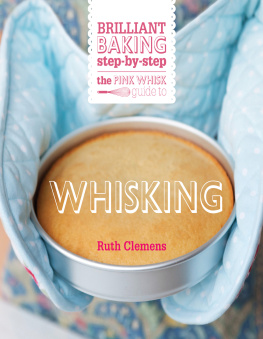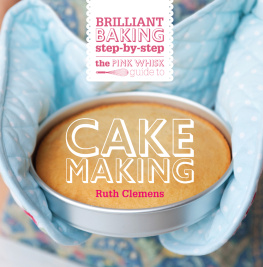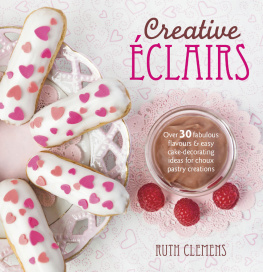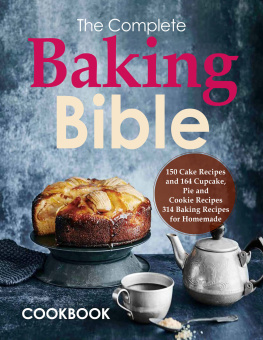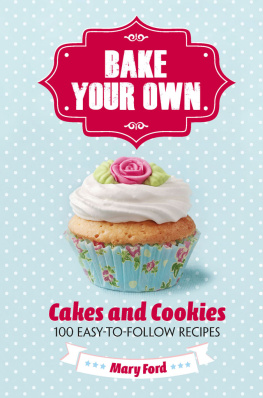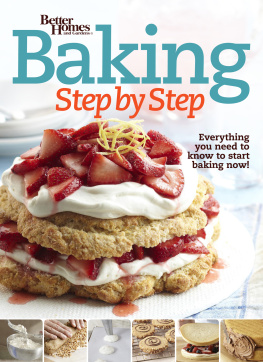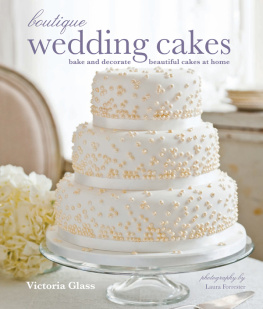The Pink Whisk Guide to Whisking
Step-by-Step Cake Making
RUTH CLEMENS
Introduction
Hello! Welcome to The Pink Whisk Guide to Whisking: Brilliant Baking Step-by-Step. Its full of delicious cake recipes for all sorts of occasions, with helpful step-by-step photos so you know youre on the right track. Some of the recipes started out life on the blog but have all been thoroughly reworked (25 versions of Golden Syrup Cake later) to make them even more delicious.
This eBook is not just about the recipes (although of course they do taste great) its about making all your cake making even better than before. The pages are loaded with tips and tricks and explanations as to why you should do a certain something at a specific stage the sort of thing thats missed out of most recipe books. Youll then be able to apply these techniques to all of your cake making turning you into a Cake Grand Master. Theyll be queuing up at the door for a slice!
This ebook focuses on whisking method cakes. There are cakes for everyone and everything. Each recipe also has its own variation change a bit of this and a bit of that and ta dah! giving you inspiration to mix up your own flavour combinations.
Ruth
x
Baking Equipment
Having the right equipment to hand makes baking a piece of cake!
Measuring Jug
Palette Knife
Paper Loaf Liners
Measuring Spoons
Digital Kitchen Scales
Over Thermometer
Paper Loaf Liners
Whisk (A Pink One is Optional)
Silicone Spatulas (Great for Scraping Sides of Bowls)
Baking Paper
Electric Hand Mixer (Speeds up your baking)
Mixing Spoon
Bundt Tin
Loaf Tin
Angel Cake Mould
Various Round Cake Tins
Baking Trays
Cooling Rack
The Basics
INGREDIENTS
Baking powder
A raising agent that is a combination of bicarbonate of soda, cream of tartar and cornstarch to absorb moisture. In conjunction with heat and moisture it reacts to form carbon dioxide which makes cakes rise. Cake mixtures made with baking powder dont mind waiting their turn to go into the oven because of this double action. It will stay fresh for about a year but is one of those things that can linger in your cupboard for some time. Be sure to check the best before date!
Bicarbonate of soda (baking soda)
This is used as a raising agent when a recipe contains acid ingredients such as vinegar, yoghurt or soured cream. It relies on the chemical reaction to form carbon dioxide which will give you a light and airy cake. Because the action of bicarbonate of soda is instant, cake mixes using this should go into the oven to be baked straight away after mixing otherwise the gases will escape and the cake wont rise as well.
Self-raising (-rising) flour
A wheat flour which has an added raising agent.
Plain (all-purpose) flour
Finely ground white flour made from wheat grain.
Tip
To turn plain flour into self-raising flour add 25g (1oz) baking powder to every 450g (1lb) plain flour and stir well to distribute it evenly.
Wholemeal (whole-wheat) flour
More nutty in flavour than white flours, wholemeal contains the wheat germ which makes it higher in fibre with a better nutritional content than white flours. It does absorb more moisture so if youre using it in place of a white flour you should also add a little more liquid such as milk.
Caster (superfine) sugar
Use a caster sugar for baking. It is more finely ground and dissolves into the cake mixture more readily. Granulated sugar can often speckle the top of a cake and can lead to a more crunchy texture.
Tip
Blitz granulated sugar in the food processor in short 30 second blasts until more finely ground if you run out of caster.
Muscovado sugars
Brown sugars contain molasses which gives the sugar a soft texture. Light brown sugar has less molasses than a dark sugar and a more delicate toffee type flavour. They should be stored, once opened, in an airtight container to prevent them from hardening. Some brown sugars are referred to as soft light or dark sugar. They are processed slightly differently to a genuine Muscovado sugar and are less rich in taste. They can be used in recipes specifying use of a Muscovado but the depth of flavour will be slightly lessened.
Tip
If brown sugar hardens place it in a small bowl. Fill another small bowl with water and place both in the microwave side by side. Microwave them on full power for 1 minute at a time until the sugar has softened.
Eggs
Eggs should be used at room temperature, so if you store yours in the fridge make sure you let them come up to room temperature before using. Recipes in the book use large eggs unless otherwise stated, and yes it really does make a difference to the finished product! Large eggs typically weigh between 63g and 73g, medium eggs 5363g, so by the time youve added 4 eggs to your mix the difference in liquid will make a big difference to your finished cake.
Butter
Butter makes cakes tender and adds colour and flavour. My recipes use a regular salted butter which avoids the need for having to add a pinch of salt. If you do want to use unsalted butter simply add tsp salt to the cake mixture along with the flour. Butter quickly absorbs flavours so when storing it in the fridge keep it in the coldest area and away from strong-flavoured foods such as onion. Substituting butter for margarine can be done if you prefer but be aware that they often have different water contents which may slightly affect the finished cake.
Chocolate
When buying chocolate for baking its best to buy either a dark 49% cocoa solids or a 70% cooks chocolate (specifically designed not to split and ruin your finished masterpiece).
Tip
To soften butter ready for baking microwave on half power in 30 second bursts until ready to use but keep your eye on it so it doesnt melt! Alternatively dice the butter and place into a bowl of room temperature water until sufficiently softened, and then drain the water away.

